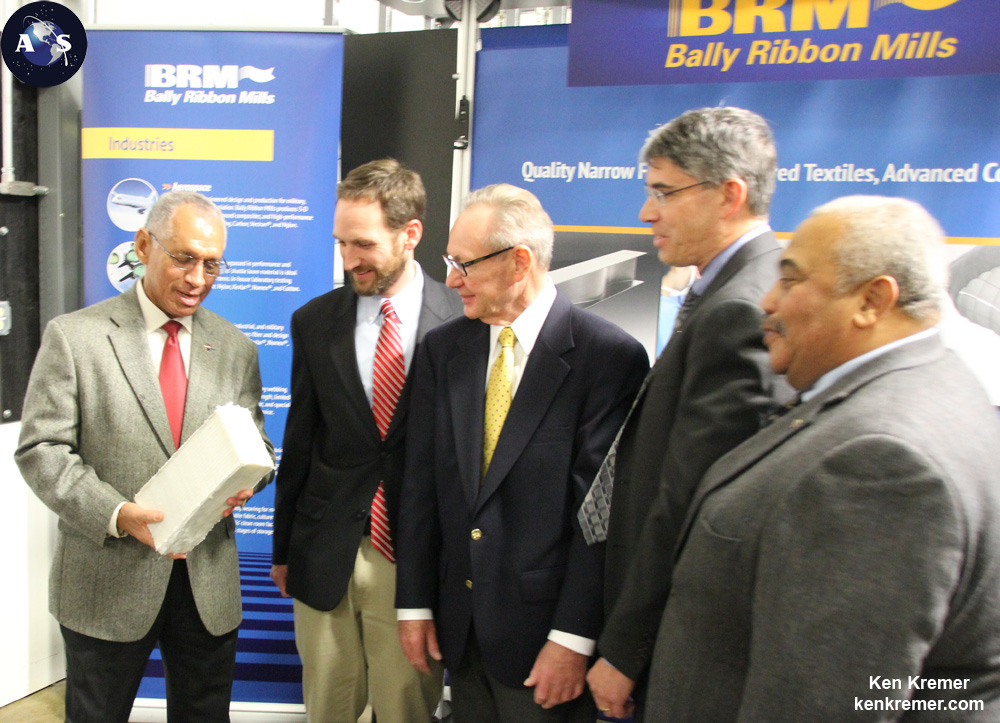
BALLY, PA and KENNEDY SPACE CENTER, FL — NASA and Lockheed Martin have decided to change a critical component of the Orion spacecraft’s heat shield for its next test flight in 2018 to include an advanced 3-D woven thermal protect system fabric that will help insure maximum safety for our astronauts returning from deep space expeditions as the vehicle experiences blistering reentry heating. It’s a must-have for Destination Mars.
NASA Administrator Charles Bolden got a first-hand look at the advanced woven fabric textiles as he personally inspected the “quartz material” component during an inspection tour of Bally Ribbon Mills (BRM) of Bally, Penn., where it is produced by “an American small business … involved in the future!”
“We cannot get to Mars without the type of materials that are being developed here [at BRM],” Bolden said during the BRM inspection tour attended by AmericaSpace. Read Part 1 of this series for more on the BRM Orion tour here.
Bolden is holding the actual 3-D woven quartz flight material—in the photo above—that will be used on all upcoming Orion flights, starting with the Exploration Mission-1 (EM-1) capsule set for blastoff in 2018 atop NASA’s gargantuan SLS booster. He is pictured also with BRM President Ray Harries, along with NASA and BRM officials.
NASA’s goal is to send Humans to Mars by the 2030s.
Bally Ribbon is a small family-owned mill company in the heart of picturesque rural Pennsylvania with just 270 employees that will play a key role in Orion and the critical thermal protection system that will keep our astronauts safe from the hellish heats of reentry.
They have developed an innovative 3-D woven material made of Quartz fibers that can withstand the higher velocities of reentry from deep space—far superior compared to the somewhat reduced velocities attained during atmospheric reentry from low-Earth orbit by NASA’s space shuttle orbiters.
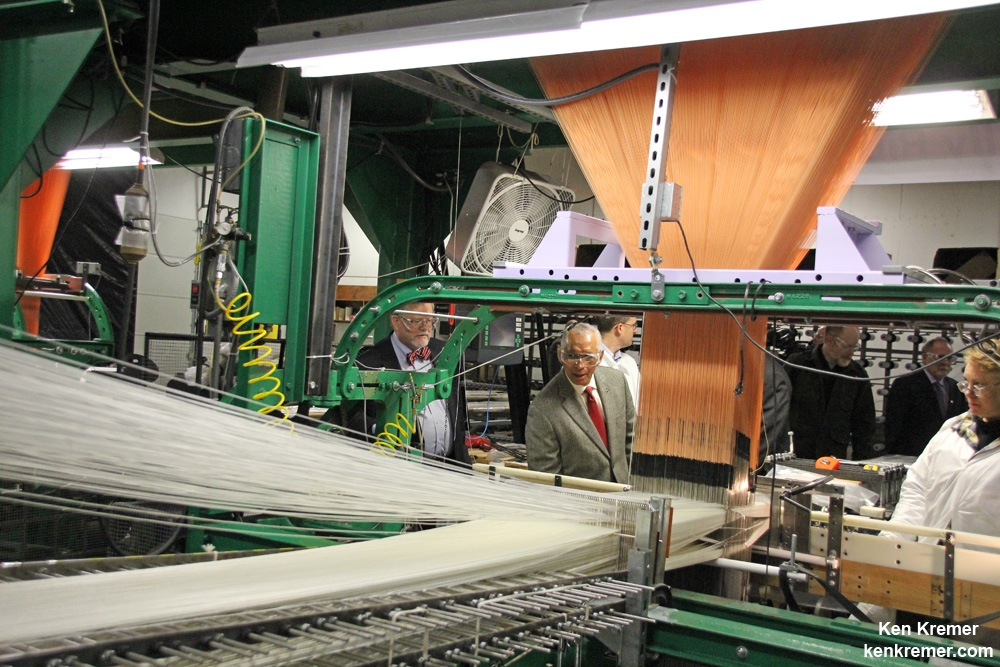
BRM is weaving a multifunctional Quartz “preform” material that will be used in thermal protection system (TPS) pads that insulate the Orion spacecraft and human crews onboard so they can survive the scorching 4000 F (2200 C) temperatures generated during reentry into Earth’s atmosphere after returning from journeys to far-flung destinations, including the Moon, asteroids, and Mars.
The 3-D woven fabric will be used in “compression pads” that serve as the interface between the Orion crew module (CM) and service module (SM) and protect the vehicle as part of the heat shield.
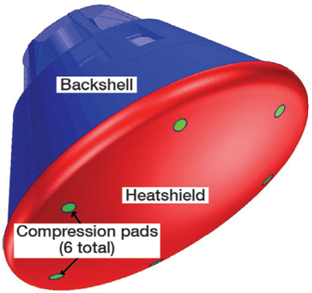
“We cannot go to Mars without the compression pads that are going between Orion—which is the crew module—and the service module, which provides power and propulsion for periods of time that astronauts are going to have to be in the vehicle when going from here to an asteroid that is in lunar orbit or on to Mars,” said Bolden.
The compression pads fill in the joints on the heat shield between Orion’s CM and SM. Their purpose is to carry the structural loads generated during launch, space operations, and pyoshock separation (explosive bolts) of the two modules.
Then in the mission’s final minutes, during descent, they must serve as an ablative TPS, withstanding the high heating of Earth reentry during the high-speed plummet of about 24,000 mph (38,000 kph).
Altogether there are six compression pads, equally spaced around the heat shield. They are integrated onto the Orion Crew Module and sit alongside the heat shield’s Avcoat TPS material.
Their position is shown in the photos and diagrams herein.
The compression pads are blocks approximately 12″ wide x 3″ thick, composed of the quartz preform material.
New and more resilient thermal insulating compression pads composed of Bally’s 3-D woven quartz fiber are needed because the current 2-D pads used on Orion’s recently completed maiden test flight—known as Exploration Flight test -1 (EFT-1)—are only suitable for Earth orbit return.
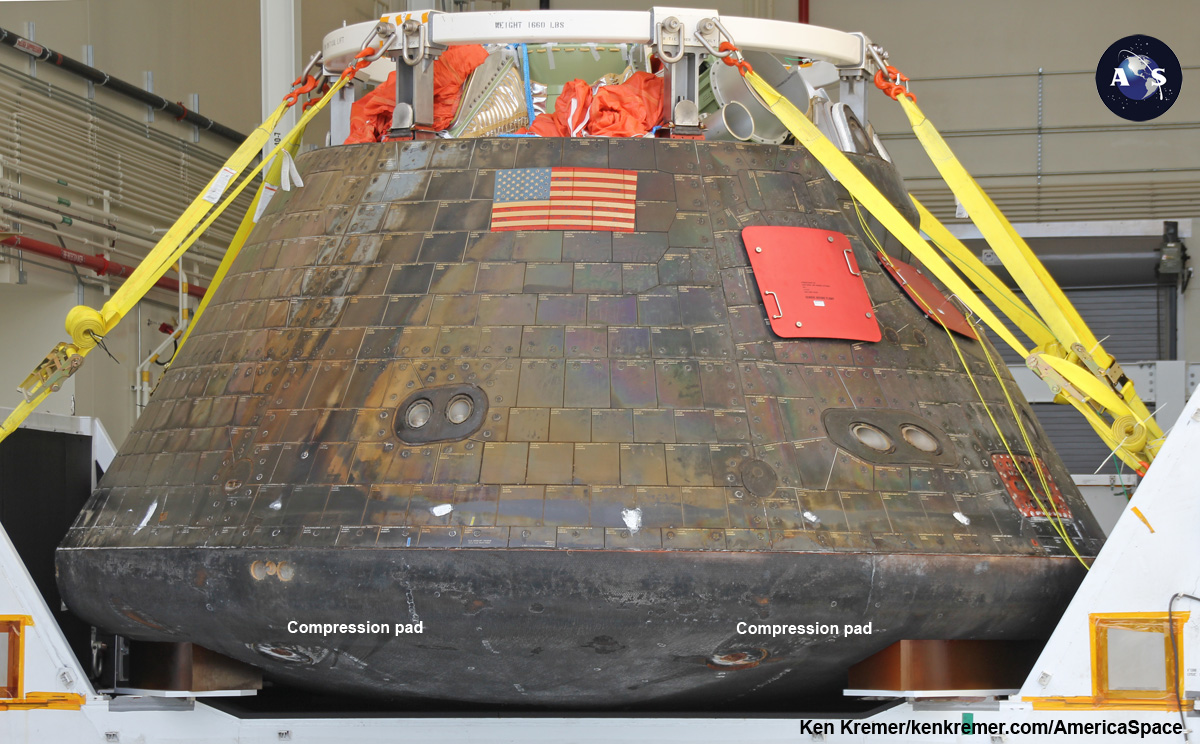
Following its launch and atmospheric reentry on Dec. 5, 2015, the Orion EFT-1 capsule approached speeds of 20,000 mph (32,000 kph), or about 85 percent of the reentry velocity for astronauts returning from journeys beyond Earth.
The current 2-D pads are not suitable as protection from the higher temperatures caused by higher speed reentries resulting from voyages back from deep space destinations.
The 2-D carbon phenolic (CP) material used for EFT-1 had a relatively low interlaminar strength, which was satisfactory for the test flight and performed as expected.
“So that’s the challenge,” said Mike Hawes, Lockheed Martin Vice President and Program Manager for Orion, in an exclusive interview with AmericaSpace at Bally Ribbon. Lockheed Martin is the prime contractor for Orion.
“The materials that we used on EFT-1 were only 2-D composite laminates. So that’s the risk that you can get separation in the layers when you are using those kinds of 2-D forms that are just all layered together,” Hawes added.
The development of this 3-D fabric is a direct result of lessons learned from Orion’s inaugural mission, and a follow on to this writer’s discussion with Administrator Bolden and Mike Hawes described in detail in Part 1 of this series here.
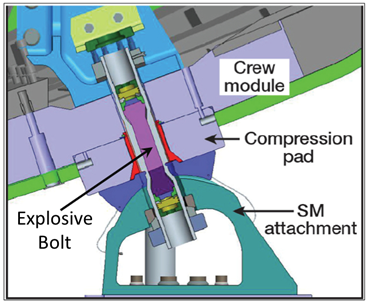
Bally’s 3-D quartz fiber material is woven using a newly developed version of a “Jacquard loom.”
“The new quartz material we are making tests out better as a thermal protection unit material than anything currently available,” said BRM President Ray Harries, during Bolden’s visit.
“This material is for deep space. What they have now works for low orbit. But when coming back from deep space and at the velocity you are coming back at, you need something better. And this is that something better!”
“This material will go on Orion in the future,” said Harries.
Harries said the new Jacquard loom and weaving is “experimental technology” and was developed with funding from NASA. The grant came from NASA’s Space Technology Mission Directorate in Washington. The work is managed by the agency’s Ames Research Center in Moffett Field, Calif.
“We made the loom ourselves. The equipment is very expensive with an investment of over a million dollars,” Harries explained.
“We are a small business. And without funding from NASA we can’t afford to do it on our own. You can’t do this type of work on a lark. You have to have help from someone. NASA has made many products that are used not just for the space program, but also all kinds of industry.”
“So the funding from NASA is really important for the government to realize. So many things come from NASA.”
Bally’s 3-D textile fabric work for NASA built on earlier work done for the Air Force.
“The folks out at the Ames Research Center who do a lot of our work with high temperature materials and trying to make sure that we have material that can withstand reentry temperatures when you come back from deep space heard about it. So Ames talked to the Air Force and that brought them here to Bally Ribbon,” Bolden elaborated.
“Bally is a very unique company providing NASA with a very unique product. They were chosen because of the quality of the product and had a track record of performance,” Bolden noted. “This is all about technology development.”
“Bally uses the [Jacquard] loom machine to take the quartz fibers [yarn] and weave them into a three-dimensional form,” Hawes explained.
“By 3-D that means there is a weaving going up the Z axis. So there is a weave that goes up and down through the Z axis. And that is what binds it all together.”
AmericaSpace asked Hawes if this material we are seeing today was test or development material or actual flight hardware material that will be used on Orion’s next flight in 2018?
“Yes, this is our baseline material for future flights: EM-1, EM-2. And whenever Bill Gerstenmaier [NASA’s Associate Administrator for Human Spaceflight] tells us there is an EM-3, EM-4, EM-5 and beyond!” Hawes replied.
“2018 is where we will use it on the first flight [EM-1]. It was developed for the next generation Orion.”
Hawes reiterated why a change in the compression pads was needed: “Again on EFT-1 we flew a material that was liable to laminate separation and that is why we wanted the 3-D weave for the future flights.”
“The problem with composite laminates is that they can separate in their layers. And that is the problem we are trying to solve. We felt we would be OK for the test flight.”
“So the problem is that for future uses we needed to solve that problem of laminate separation. So NASA has been working with Bally to develop that three-dimensional weave.”
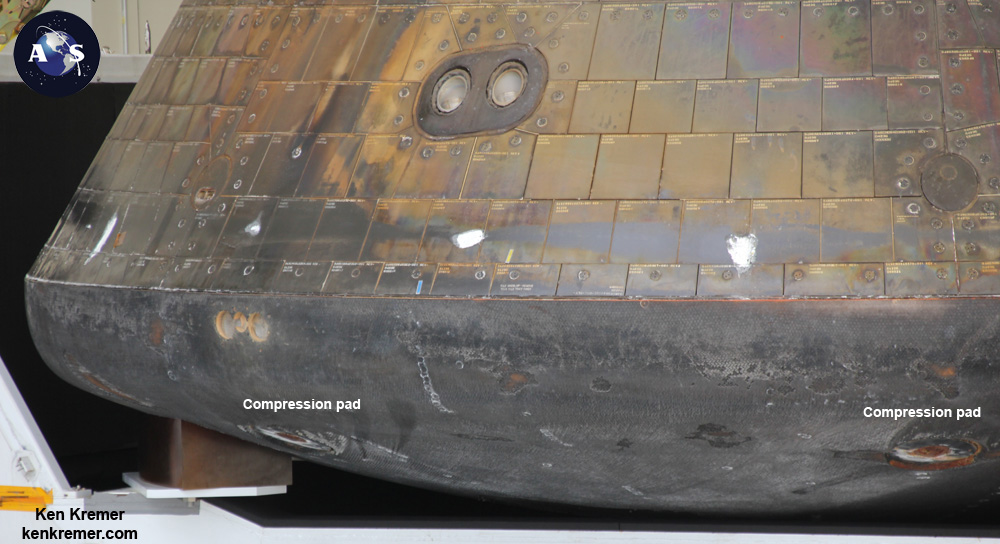
NASA’s Space Technology Mission Directorate funded the project barely three years ago, explained Ethiraj Venkatapathy, Chief Technologist of Entry Systems and Technologies Division at NASA Ames, in an exclusive interview with AmericaSpace:
“NASA was conceiving/exploring the idea of weaving the TPS working with BRM. We asked Bally to explore if they could make a specialized preform made of quartz fibers. The specifications were very demanding and Bally had to design new hardware to be able to weave the pre-form. They were successful.”
“As a result, a new material was invented and tested in less than 36 months for replacing the deficient EFT-1 hardware and enabling future missions to the Moon and Beyond.”
What is the history, if any, for this type material?
“From my knowledge, a composite, multifunctional material of this size and specification has never been manufactured before. The weaving of a 12″ wide x 3″ thick quartz preform has most likely never been done before!” Venkatapathy stated.
What is the next step after Bally produces the 3-D woven material?
“We can take that material, the white quartz, and send it out to San Diego [to SDC (San Diego Composites)] and it gets resin impregnated. That gives it the strength and shaping,” said Hawes.
“SDC infuses a specific resin and cures it. The curing with the resin locks the quartz fibers in place and produces blocks mechanically strong and thermally capable of withstanding very high heating and with low conductivity, an exceptional thermal protection material,” added Venkatapathy.
“The resin infusion of such a thick and large part is another enormous challenge. Overcoming these challenges is enabling Orion for future missions. To be part of this adventure and success is very meaningful to me as a NASA Employee in the Space Technology Mission Directorate,” said Venkatapathy.
“Then we literally machine that down into these compression plugs that go around the explosive bolts that control the separation between the CM and SM,” said Hawes.
So the new plugs will replace the ones on EFT-1 on future flights to “get away from that lamination separation.”
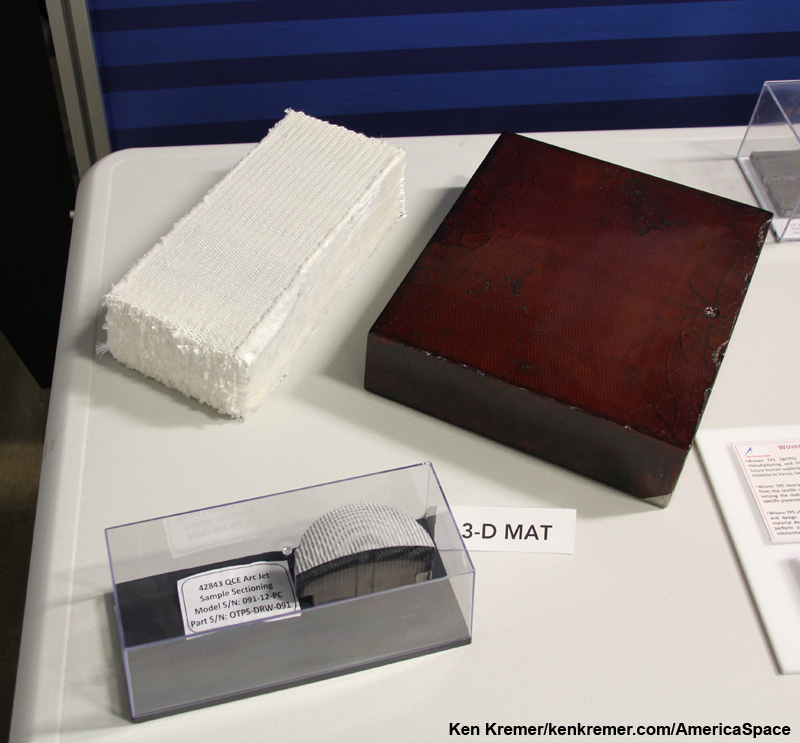
“Orion is a much bigger shape [capsule] then we have ever brought back from space. So it is more challenging. The heating effects are much tougher than with Apollo,” said Hawes.
The Orion crew module is 16.5 feet (5 meters) in diameter, versus the Apollo command module was 12.8 feet (3.9 m) in diameter.
“So we used Apollo material [Avcoat] for the base of the heart shield. But you have these specialized areas where you have these specialized joints and connections between the two modules. And that is where we came to look at this unique material like that which Bally is developing,” Hawes elaborated.
The precise location of the compression pads is shown in photos from the Orion homecoming to the Kennedy Space Center on Dec. 19, 2014.
“The heat shield surface [survived] in excellent condition,” said Jay Feldman, Technical Lead for
3D Multifunctional Ablative Thermal Protection System (3D MAT), in an exclusive interview with AmericaSpace. “The scrapes and damage you can see in the heat shield are from the US Navy recovery operation.”
Bally’s 3-D fabric will have use in unmanned science missions also.
“This new material is also woven into blankets for future thermal protection systems for future planetary science missions,” said Hawes.
More on that in the next story!
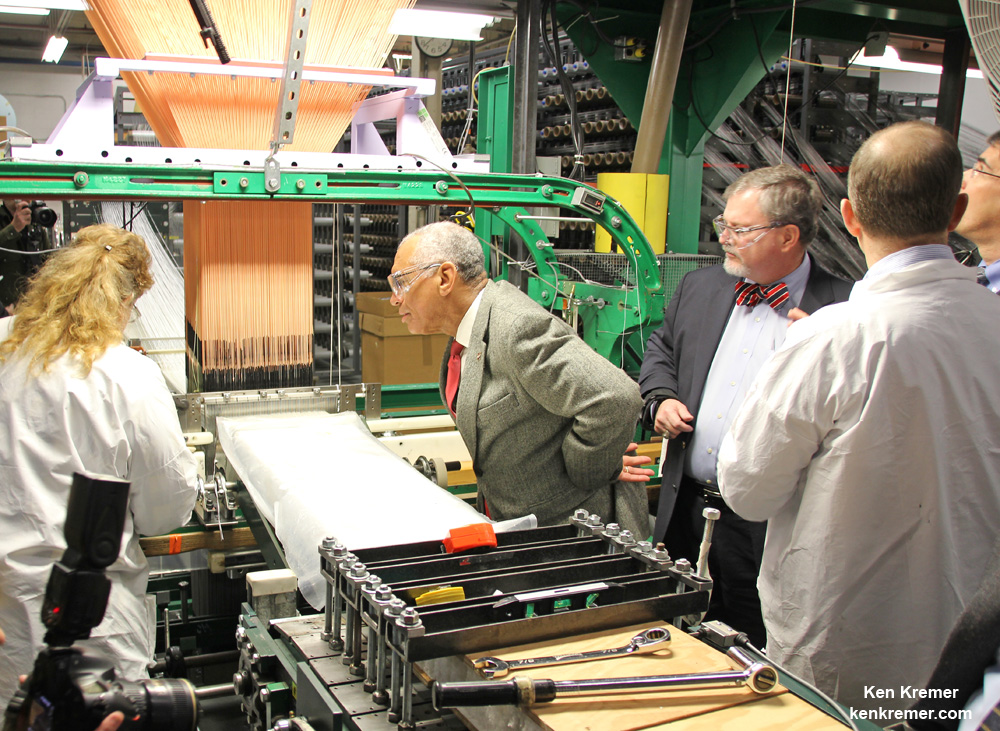
“The importance of Bally Ribbon and our being here for Orion is that Bally is an example of what is the heart and soul of everything NASA does. We have big contractors that do big projects like Lockheed Martin and Boeing and others,” Bolden said.
“But when you get down to the fine points, the components, they are generally done by an American small business. So I wanted to come out and see a small business that had been engaged with us, and that had a track record of performance, but was also involved in the future.”
“Our bread and butter and our lifeblood is small business in America. We do one-offs. We don’t mass produce. That’s the important thing. So we need niche companies who do very unique things that can satisfy a need that we have.”
“So that’s one of the reasons that NASA is doing business with small business so much. It’s because they do the kinds of very unique things that we need.”
“I had never heard of Bally Ribbon to be quite honest. After today, every time I look at a vehicle we have I will know you all [Bally Ribbon] are there.”
“So, the path to Mars goes through Bally, Pennsylvania!” NASA Administrator Charles Bolden proclaimed.
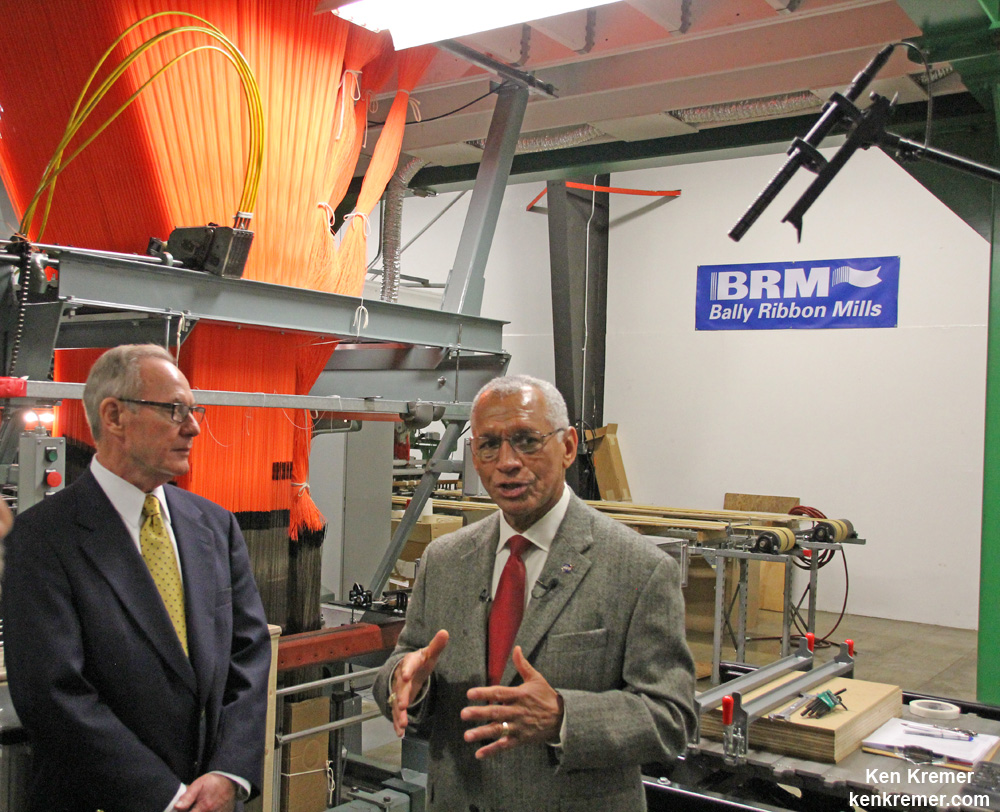
Read my story about the re-flight of the EFT-1 capsule on the Ascent Abort-2 (AA-2) mission here. It’s due to launch atop a Peacekeeper missile from Space Launch Complex 46 SLC-46) at Cape Canaveral Air Force Station.
Stay tuned here for continuing updates on Orion and more.
Want to keep up-to-date with all things space? Be sure to “Like” AmericaSpace on Facebook and follow us on Twitter: @AmericaSpace
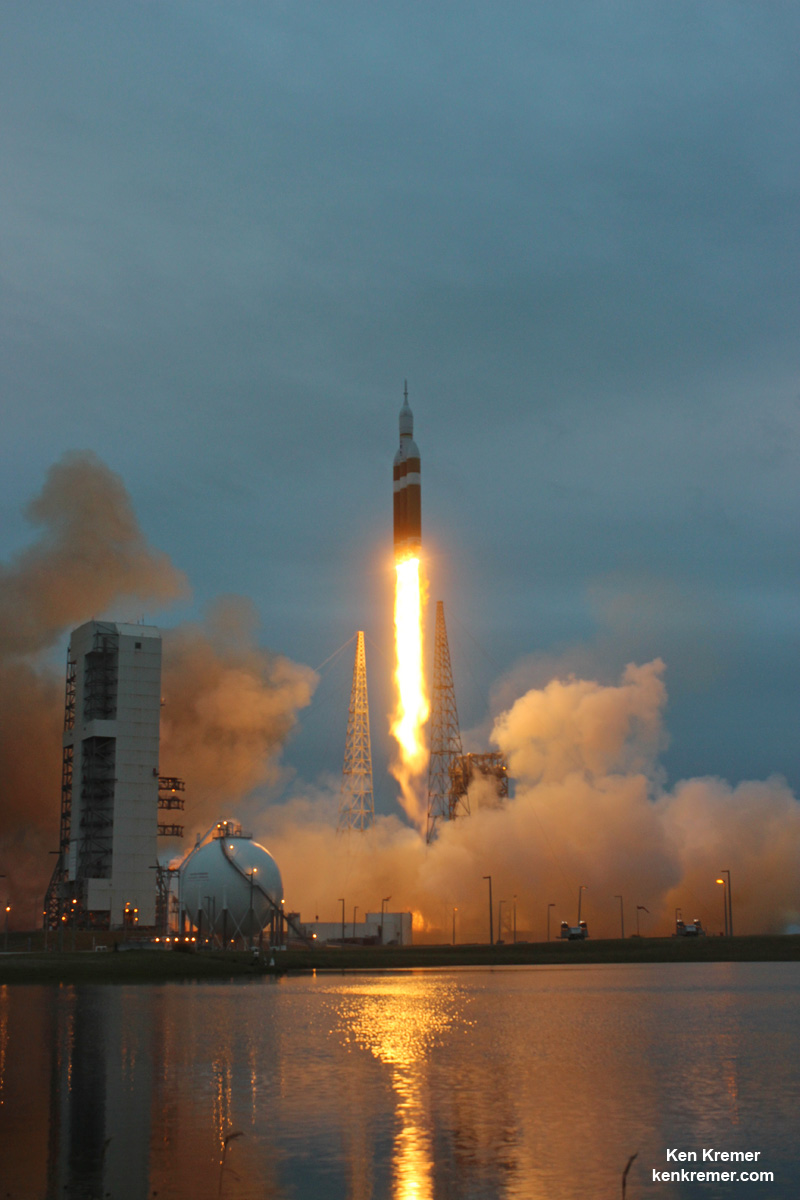
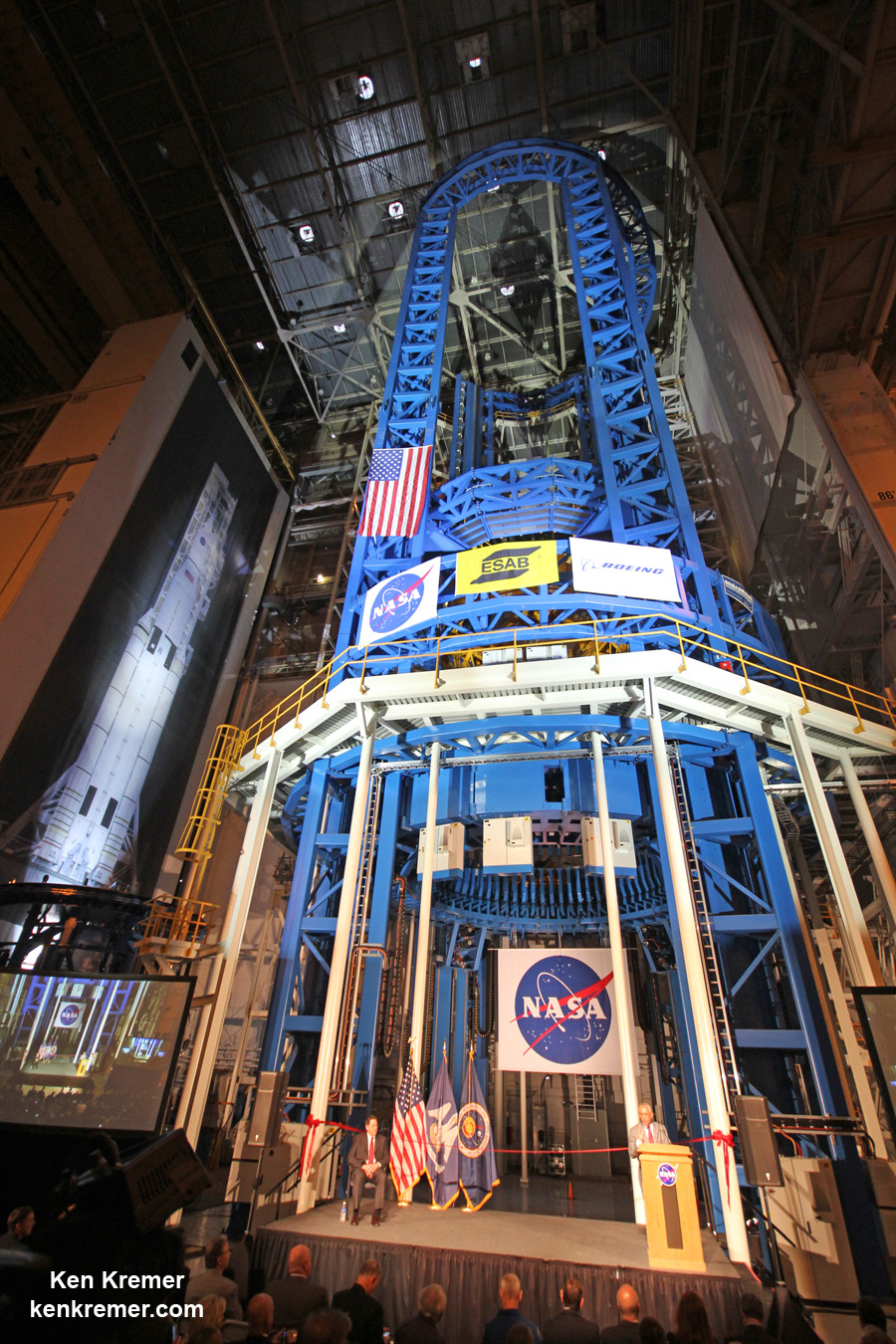




Why is it being called 3-D? Aren’t all things manufactured 3-D to begin with? That’s usually only a term reserved for CGI and movies.
Some composites are in layers of fabric depending on the resins to hold the layers together. 3-D as described in this article has fabric yarns that basically sew the various layers together so as not to depend on laminate strength entirely to hold the layers together.
Normal can be visualized as several layers of dinner plates stacked and glued together, with 3-D being a solid block of ceramic the same size as the plate stack fired in the kiln.